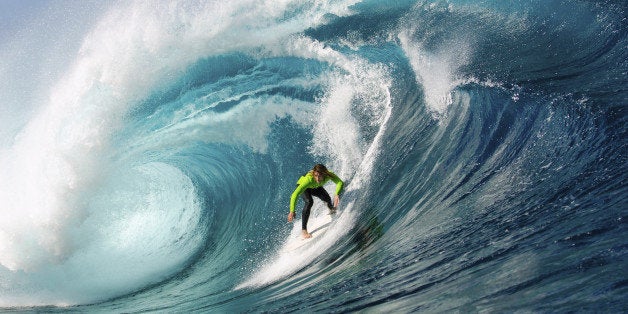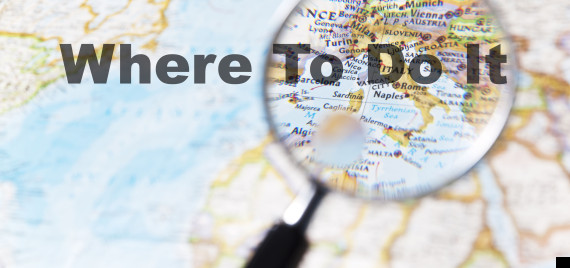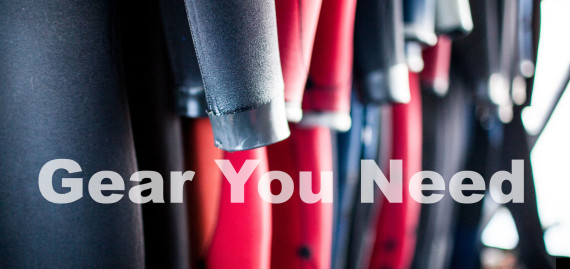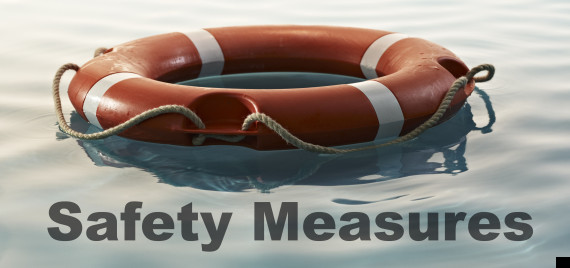
Sunshine, waves and a bit of an adrenaline rush -- what's not to love about surfing? Not only does the sport connect you with nature, but also with people who share the waves. "In the water everyone is equal regardless of what they do for a living or where they live," Bruce Gabrielson, master level NSSIA-certified surfing instructor, tells The Huffington Post.
But the benefits of the sport go far beyond a fleeting thrill and some relaxation. Riding waves offers a cardio workout from paddling, strengthens the shoulders and back, and amps up leg and core strength, once you begin to stand for longer periods of time. (And there is even ongoing research to yet-unknown health benefits of recreational surfing.) "Surfing is the ultimate meditation and the ultimate rush -- I don't know many other sports that offer both feelings at once," Johnie Gall, surfer and founder of outdoor women's site Dirtbag Darling, tells The Huffington Post.
But maybe your impression of surfing has always been that it's a bit inaccessible. That you need to have a certain know-how, or fancy gear, in order to partake in the sport. Well, we talked to the experts to remove the veil of the unknown, to get you on the board and out in the water. Here's what a beginner surfer needs to know:

The surf's up all over the country, even if you're landlocked. West Coast surfers head to California's Santa Cruz, San Clemente and Linda Mar Beach. Those in the East flock to Ocean City, Maryland, and Montauk, New York. And even New York City dwellers can catch some waves at Rockaway Beach, just 25 miles outside of Manhattan. But you don't need to live on a coast to ride a board. For Midwesterners, big lakes, like Lake Michigan, offer surfing opportunities as well.

It's probably best to take a few lessons and make sure that surfing is your sport before investing a bunch of cash into surf supplies. Once you do decide you're ready to commit to the waves, most beginners start out with a longboard more than 9 feet long, Gabrielson tells The Huffington Post.
Gall says that while most beginners go for a "foamie" (a board made out of foam that's generally more stable than a regular board, and hurts less if it hits a surfer during a wipeout), she suggests investing in the real deal if you're committed to surfing. "You can find good deals on used surfboards on Craigslist, especially in coastal towns, and take it to a repair shop to fix up the dings and dents," she says.
Unless you're one of the lucky ones with warm waves -- like those in Hawaii -- or you have the cold water tolerance of a polar bear, you'll likely want to invest in a wetsuit. Wetsuits keep you warm by trapping a thin layer of water between your body and the suit, which your body heats to a more comfortable temperature. While wetsuits come in many shapes, sizes and styles, the thickness of a suit is measured using two numbers. The first number refers to the thickness of the material around your torso, and the second number refers to the thickness around your limbs. A wetsuit for warmer waters might not have fabric on the arms and legs, and is called a "shorty." But since most beginner surfers aren't going to start the sport in the colder off-season, "a 3/2 millimeter full suit and a two millimeter shorty are the best wetsuits for the spring, summer and fall," Gabrielson says, meaning the torso of the suit would be 3 millimeters thick (or 2 millimeters for the shorty) and the material around the limbs would be 2 millimeters thick.
He also recommends newbie surfers use a rash guard to prevent skin chafing. Rash guard is a polyester, nylon and sometimes spandex shirt that looks similar to a running T-shirt or long-sleeve T-shirt. When worn under a wetsuit, it can provide an extra layer of warmth and prevent rubbery wetsuits from chafing near the seams, or in other places they may rub.
- Pop-ups: A pop-up is the movement of springing from your belly to your feet as you balance on the surfboard. The idea is to move as swiftly as possible to help maintain balance. Start on your stomach, place your hands on either side of your ribs (think baby cobra, yogis) and engage your abs to hop your feet beneath you, keeping your knees bent at a nearly 90-degree angle.
- Yoga: Dive into your downward dog before diving into the ocean. Yoga can help strengthen muscles, improve balance and increase flexibility, all great skills for surfing."Yoga is an excellent cross-training exercise for newbie and experienced surfers," Frank Cullen, owner and operator of the NSSIA-certified New York Surf School in Rockaway Beach, tells The Huffington Post.
- Burpees: This dreaded exercise can actually seriously improve your surfing, according to Gabrielson. "The NSSIA recommends exercises that develop explosive strength as the primary muscle-builder," he says. To tackle a burpee the right way, squat down, place your hands on the ground, jump your feet back into a plank, drop into a push-up, jump your feet back to your hands and leap explosively into the air.
- Practice on the beach before you jump into the water. This will help your body learn the technique of jumping up on the board. "Of course, when you're in the water, you'll probably forget everything, but having that foundation will help you progress," says Gall.
- Paddle hard. Gabrielson recommends paddling hard in order to catch the wave. The idea is to get the board moving almost as fast as the approaching wave.
- Keep your eyes up. Cullen warns against looking down as you pop up. Keeping your focus up, in front of your board, will make it easier to balance and stand up.
- Crouch down. Newbie surfers should keep their sense of gravity as low as possible by popping up with bent knees and arms spread wide, Cullen says. "What this does is radically change a person's center of gravity from being roughly 6 feet tall and 2 feet wide, to 4 feet tall and 5 feet wide," he says.
- Raise the surfboard's nose. Keeping the front end of the board at least 2 inches out of the water will help prevent nose dives, says Gabrielson.
- Commit to staying on the board. It can be scary to feel unstable on top of the water, but Gall suggests staying on the board for as long as possible -- rather than jumping off -- even if you feel yourself losing balance.

It's not all smiles and waves out there. Despite the go-with-the-flow attitude many pros exhibit, surfing is an extreme sport, with plenty of dangers that beginners should be aware of. Some basic safety instructions from Gabrielson include:
- Never panic.
- Always keep the board perpendicular to approaching waves while going out.
- Fall backward with your hands in front of your face.
- Don't get in an approaching surfer's way.
- Embrace the buddy system.
When choosing a surf spot, always scope the waves, assess the other surfers and formulate a plan before paddling out. "Look around and usually in any given surfing area there will be the top spot with high-level surfers. There will be another area, just off to the side of them, where people of good ability, but a little bit lower, will be sitting in. A little bit further down the beach will be the newbies," Cullen tells The Huffington Post. "This is a great place to hang with surfers of your same ability. It's easy to make friendships with people surfing at your same level and not be self-conscious."
So long treadmills, we're going rogue! This story is part of our Go Rogue series, where you'll find beginner guides to the outdoor sports you've always wanted to try.
All photos from Getty Images unless otherwise noted.